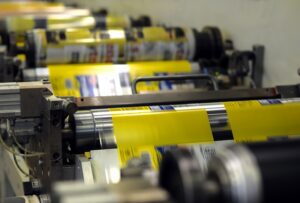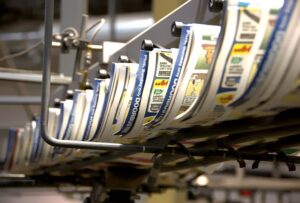When the government began to put stricter environmental goals for printers in place, there was a ripple effect throughout the supply chain. Printers began to examine alternate technologies in order to eliminate the solvent-based systems that give off volatile organic compounds (VOCs), which the U.S. Environmental Protection Agency (EPA) wants to reduce and/or eliminate.
For ink formulators, one possibility was to create water-based systems, which would accomplish the goal of reducing VOCs. The water-based inks have improved over time, and today, these water-based systems have had a major impact in a number of areas, particularly in flexo.
However, there is still room to grow. Water-based inks’ future growth depends on what the EPA does, and whether printers are looking to change over to water once their incineration and capture and control equipment depreciates. Meanwhile, formulators are looking to improve the properties of water-based inks to reach into other segments of the market.
Water-based inks have made major inroads in the flexo packaging market. According to the National Association of Printing Ink Manufacturers’ (NAPIM) 1999 State of the Industry report, water-based flexo inks account for 37 percent of the packaging market.
[/fusion_text][/fusion_builder_column][fusion_builder_column type=”1_1″ layout=”1_1″ background_position=”left top” background_color=”” border_size=”” border_color=”” border_style=”solid” spacing=”yes” background_image=”” background_repeat=”no-repeat” padding_top=”” padding_right=”” padding_bottom=”” padding_left=”” margin_top=”0px” margin_bottom=”0px” class=”” id=”” animation_type=”” animation_speed=”0.3″ animation_direction=”left” hide_on_mobile=”no” center_content=”no” min_height=”none” last=”no” hover_type=”none” link=”” border_position=”all”][fusion_text]
“Flexo has been the strongest market for water-based inks in the corrugated, folding carton, a lot of the paper market, multi-wall bags and low to medium film market, and it is continuing to emerge in the higher-end markets,” said Chris Patterson, director of product development, packaging inks, for Flint Ink North America. “The flexo market grew up with water-based inks. As certain elements of flexo improved, so did water-based inks.”
“There are certain market segments that are almost exclusively water-based,” said Gerald McLain, marketing manager, packaging inks, for Sun Chemical Corporation. “For example, it is the predominant process in narrow web label. Other areas where water flexo is the primary process include folding cartons, plastic grocery sacks and department store bags, multi-wall bags, corrugated, and envelope printing.
“There has been significant growth in the usage of water-based ink in what I call ‘the easy market’: paper products, paper bags, corrugated products, both pre-printed ad post-printed, multi-wall bags, and polyethylene products such as grocery sacks and polyethylene parts bags, and milk cartons,” said Darryl Sagraves, technical market manager for Sun Chemical Corporation. “Water-based ink have achieved a dominant position in these areas.”





